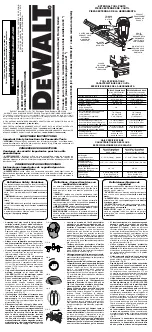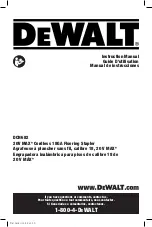
41
EnGLIsh
Dryfire Lock Out Feature (Fig. A)
Tool is equipped with a dryfire lock out feature to prevent tool
from cycling when there are no fasteners loaded. When no
fasteners are visible in the low staple indicator
15
, the tool is
running low on fasteners. If this happens, the tool will be locked
out and will not actuate until more staples are loaded. (Refer to
Loading the Tool.
)
Mode Selection (Fig. A, F)
The flooring stapler is capable of firing staples using sequential
and rapid sequential actuation. Before operating this tool, look
at the selector switch to determine the actuation mode. Read all
instructions before selecting actuation mode.
WARNING:
Keep fingers AWAY from trigger when not
driving staples to avoid accidental fastener discharge.
NEVER
carry tool with finger on trigger. In rapid
sequential mode tool will drive a staple if contact trip is
bumped while trigger is depressed.
Sequential Mode
Use sequential actuation mode for intermittent stapling where
very careful and accurate placement and depth control is
desired. The sequential actuation mode provides the maximum
delivery of power for driving the longest staples.
To operate the stapler in sequential actuation mode:
1. Slide the selector switch to expose the single staple icon
.
2. Release the trigger lock-off
2
.
3. Fully depress nosepiece against the work surface (motor
will start).
4. Pull trigger (staple will drive into work surface).
5. Release the trigger and raise the stapler from the work
surface.
nOTE:
The tool motor returns to full speed
automatically without the contact trip
5
being depressed.
6. Repeat steps 3–5 for next application.
NOTICE:
The contact trip needs to be depressed followed
by a trigger pull for each staple followed by a release of
both the contact trip and trigger after each staple.
Rapid Sequential Mode
In rapid sequential mode, the motor rotation speed is
automatically restored after driving a staple to allow fast
consecutive stapling. While offering the ability to drive
more staples in less time, this mode quickly depletes the
battery charge.
1. Use the mode selector switch
7
to select rapid sequential
mode.
2. Release the trigger lock-off
2
.
3. Push the contact trip
5
against the work surface.
4. Pull the trigger
1
to actuate the tool.
5. Release the trigger
1
. Keeping the tool and contact trip
pressed into the workpiece slide the stapler along the
flooring material. The motor will continue to run and the
tool can be actuated at any time by pulling the trigger.
Please follow flooring manufacturer’s recommended
fastener schedule for proper staple spacing.
nOTE:
In rapid sequential mode, the tool motor returns
to full speed automatically without the contact trip
5
being depressed.
Adjusting Depth (Fig. I)
The depth that the fastener is driven can be adjusted using the
depth adjustment wheel
3
on the side of the tool.
WARNING: To reduce risk of serious injury from
accidental actuation when attempting to adjust
depth,
ALWAYS:
• Remove battery pack.
• Engage trigger lock-off.
• Avoid contact with trigger during adjustments.
1. To drive the staple shallower
, rotate the depth
adjustment wheel
3
away from the nose of the stapler.
2. To sink a staple deeper
, rotate the depth adjustment
wheel
3
toward the nose of the stapler.
Headlights (Fig. J)
There is a headlight
4
located on each side of the stapler.
Headlights turn on upon battery insertion, activation of
the trigger, or depressing the contact trip. The lights will
automatically shut off after 20 seconds unless tool remains
in use.
nOTE:
These headlights are for lighting the immediate work
surface and are not intended to be used as flashlights.
Low battery indicator:
The left-side headlight will flash four
consecutive times and then shut down to indicate low battery.
Jammed staple indicator:
The right-side headlight will flash
continually if a staple becomes jammed in the nosepiece (Refer
to
Clearing a Jammed Staple
).
Clearing a Jammed Staple (Fig. A, K)
If a staple becomes jammed in the nosepiece, keep the tool
pointed away from you and follow these instructions to clear:
1. Remove battery pack from tool and engage the trigger
lock-off.
2. Press the magazine latch
14
and remove any
loaded staples.
3. Visually check inside magazine for any jammed staples.
4. Remove bent staple, using pliers if necessary.
5. If driver blade is in the down position, cycle the stall release
lever
10
using enough force to fully slide it to the other end
of the slot in the housings.
6. Reinsert staples into magazine (Refer to
Loading the Too
l)
7. Reinsert battery pack.
nOTE
: The tool will disable itself and not reset until the
battery pack has been removed and reinserted.
Cold Weather Operation
When operating tools at temperatures below freezing:
1. Keep tool as warm as possible prior to use.
2. Actuate the tool 5 or 6 times into scrap timber before using.













































